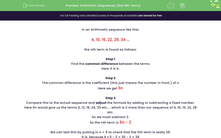In an arithmetic sequence like this:
4, 10, 16, 22, 28, 34 ...
the nth term is found as follows:
Step 1
Find the common difference between the terms.
Here, it is 6.
Step 2
The common difference is the coefficient (this just means the number in front.) of n.
Here, we get 6n
Step 3
Compare this to the actual sequence and adjust the formula by adding or subtracting a fixed number.
Here, 6n would give us the terms 6, 12, 18, 24, 30 etc.... which is 2 more than our sequence of 4, 10, 16, 22, 28 etc.
So we must subtract 2.
So the nth term is 6n - 2
We can test this by putting in n = 5 to check that the 5th term is really 28.
It is, because 6 x 5 - 2 = 30 - 2 = 28
Let's get started on the questions now!








